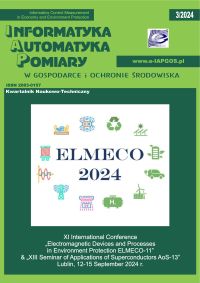[1] Arsirii O. O., Ivanov O. V., Smyk S. Yu.: Risk zones from the filling stations modelling with application of geoinformation technology. Herald of Advanced Information Technology 4(1), 2021, 84–95 [https://doi.org/10.15276/hait.01.2021.8].
DOI: https://doi.org/10.15276/hait.01.2021.8
[2] Barabash O. et al.: Method of identification of tree species composition of forests on the basis of geographic information database. Advanced Information Systems 6(4), 2022, 5–10 [https://doi.org/10.20998/2522-9052.2022.4.01].
DOI: https://doi.org/10.20998/2522-9052.2022.4.01
[3] Barabash O. et al.: The assessment of the quality of functional stability of the automated control system with hierarchic structure. IEEE 2nd International Conference on System Analysis & Intelligent Computing. Conference Proceedings. 05-09 October, 2020, Kyiv, Ukraine, 158–161.
[4] Barabash O., Kyrianov A.: Development of control laws of unmanned aerial vehicles for performing group flight at the straight-line horizontal flight stage. Advanced Information Systems, 7(4), 2023, 13–20 [https://doi.org/10.20998/2522-9052.2023.4.02].
DOI: https://doi.org/10.20998/2522-9052.2023.4.02
[5] Deineko L. V.: Development of industry to ensure the growth and renewal of the Ukrainian economy. National Academy of Sciences of Ukraine, State University “Institute of Economics and Forecasting of the National Academy of Sciences of Ukraine”. Kyiv, 2018.
[6] Everitt B. et al.: Miscellaneous Clustering Methods. Wiley, 5th Edition, 2011.
[7] Govender P., Sivakumar V.: Application of k-means and hierarchical clustering techniques for analysis of air pollution: a review (1980–2019). Atmospheric Pollution Research 11(1), 2020, 40–56 [https://doi.org/10.1016/j.apr.2019.09.009].
DOI: https://doi.org/10.1016/j.apr.2019.09.009
[8] Kozulya T. V., Yemelyanova D. I.: Environmental risk at different levels of research of natural and man-made systems, information provision of its assessment. Problems of information technologies 17, 2015, 138–144.
[9] Laptiev O. et al.: The method of construction of the law of safety management of critical infrastructure objects under the conditions of external uncontrolled influences. CEUR Workshop Proceedings 3624, 2023, 291–300.
[10] Li C. et al.: Qualitative determination of volatile substances in different flavored cigarette paper by using headspace-gas chromatography-ion mobility spectrometry (HS-GC-IMS) combined with chemometrics. Heliyon 9(1), e12146, 2023, 1–14 [https://doi.org/10.1016/j.heliyon.2022.e12146].
DOI: https://doi.org/10.1016/j.heliyon.2022.e12146
[11] Malley C. S., Braban C. F., Heal M. R.: The application of hierarchical cluster analysis and non-negative matrix factorization to European atmospheric monitoring site classification. Atmospheric Research 138, 2014, 30–40 [https://doi.org/10.1016/j.atmosres.2013.10.019].
DOI: https://doi.org/10.1016/j.atmosres.2013.10.019
[12] Ogasawara Y., Kon M.: Two clustering methods based on the Ward's method and dendrograms with interval-valued dissimilarities for interval-valued data. International Journal of Approximate Reasoning 129, 2021, 103–121 [https://doi.org/10.1016/j.ijar.2020.11.001].
DOI: https://doi.org/10.1016/j.ijar.2020.11.001
[13] Qaddoura R., Faris H., Aljarah I.: An efficient evolutionary algorithm with the nearest neighbor search technique for clustering analysis. J Ambient Intell Human Comput 12, 2021, 8387–8412 [https://doi.org/10.1007/s12652-020-02570-2].
DOI: https://doi.org/10.1007/s12652-020-02570-2
[14] Radlovska K. O.: A continuously operating automated ecological and technological model of environmental monitoring to increase the level of environmental safety and develop a strategy for the sustainable development of Prykarpattia. Monitoring, modeling and forecasting of the state of the environment 1(11), 2015, 127–140.
[15] Shevchenko R. Yu.: Mobile geo-informational system of ecological monitoring of the city of Kyiv as a scientific-methodological model of prevention of risks of anthropogenic influence. Environmental sciences 2(25), 2019, 55–63 [https://doi.org/10.32846/2306-9716-2019-2-25-9].
DOI: https://doi.org/10.32846/2306-9716-2019-2-25-9
[16] Shvaiko V. et al.: Methods for detecting fires in ecosystems using low-resolution space images. Informatyka, Automatyka, Pomiary w Gospodarce i Ochronie Środowiska – IAPGOS 11(1), 2021, 15–19 [https://doi.org/10.35784/iapgos.2576].
DOI: https://doi.org/10.35784/iapgos.2576
[17] Sobchuk V. et al.: Adaptive accumulation and diagnostic information systems of enterprises in energy and industry sectors. E3S Web of Conferences 250, 2021, 82–87 [https://doi.org/10.1051/e3sconf/202125008002].
DOI: https://doi.org/10.1051/e3sconf/202125008002
[18] Svynchuk O. et al.: Development of the information system for monitoring time changes in forest plantations based on the analysis of space images. Eastern-European Journal of Enterprise Technologies 5(2/119), 2022, 31–41 [https://doi.org/10.15587/1729-4061.2022.265039].
DOI: https://doi.org/10.15587/1729-4061.2022.265039
[19] Vasiutynska K., Arsirii O., Ivanov O.: Development of the method for assessing the action zones of hazards in an emergency at a city filling station using geoinformation technology. Technology Audit and Production Reserves 6(3/38), 2017, 29–38 [https://doi.org/10.15587/2312-8372.2017.119505].
DOI: https://doi.org/10.15587/2312-8372.2017.119505
[20] Zhao M., Liu X.: Regional risk assessment for urban major hazards based on GIS geoprocessing to improve public safety. Safety Science 87, 2016, 18–24 [https://doi.org/10.1016/j.ssci.2016.03.016].
DOI: https://doi.org/10.1016/j.ssci.2016.03.016
[21] [https://minjust.gov.ua/m/samovilne-spalyuvannya-listya-ta-suhoi-travi-poza-zakonom]. (available: 11.04.2024).
[22] [https://saveecobot.com] (available: 11.04.2024).
[23] [https://asm.kyivcity.gov.ua] (available: 11.04.2024).
[24] [https://www.ksv.biz.ua/GOST/DSTY_ALL/DSTU2/dstu_7134-2009.pdf] (available: 11.04.2024).
[25] [https://www.kmu.gov.ua/npas/155861368] (available: 11.04.2024).
[26] [https://zakon.rada.gov.ua/rada/show/n0002556-00#Text]. (available: 11.04.2024).







